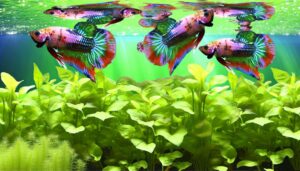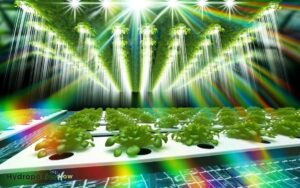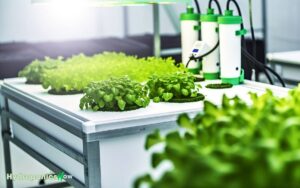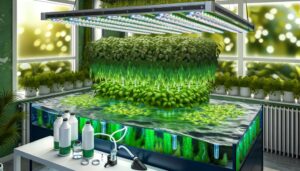How Much Water Does a Hydroponic Lettuce Plant Need?
To grow hydroponic lettuce, monitor water levels closely to guarantee ideal growth. Keep water consistently reaching the roots without submerging the plant base.
In Deep Water Culture (DWC), maintain water just below the net pots, while Nutrient Film Technique (NFT) needs a thin film of water over roots.
Adjust based on temperature, humidity, and growth stage. Aim for a pH between 5.5 and 6.5 and maintain Electrical Conductivity (EC) between 1.2 and 2.0 mS/cm.
Efficient water use focuses on keeping roots moist but not waterlogged. For detailed maintenance tips and optimizing growth, continue exploring resources.
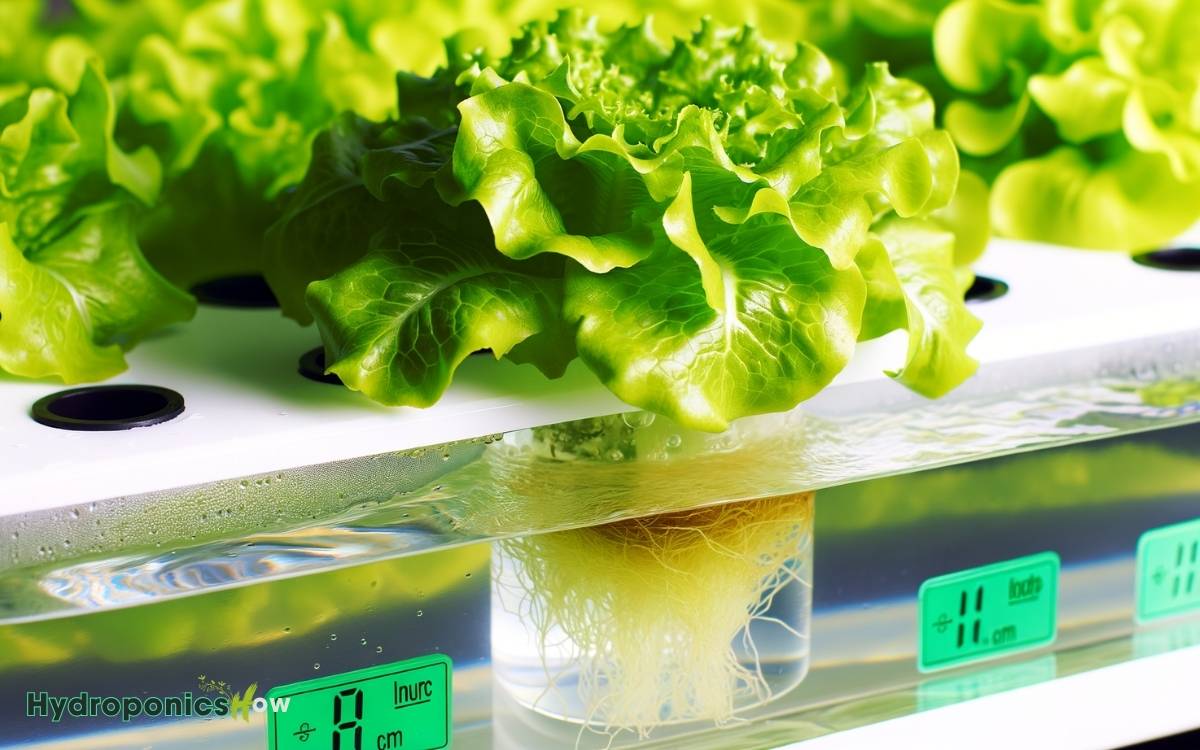
Key Takeaways
Understanding Hydroponic Systems
Hydroponic systems, frequently utilized for their efficiency, eliminate the need for soil by delivering nutrients directly to the plant roots through a water-based solution.
You’ll find that hydroponic setups come in various forms, such as nutrient film technique (NFT), deep water culture (DWC), and drip systems.
Each system guarantees excellent nutrient absorption, fostering rapid growth and higher yields compared to traditional soil methods.
To maintain these systems, you must monitor pH levels, nutrient concentration, and oxygenation. Consistent water circulation prevents root rot and ensures even nutrient distribution. Precision is critical; small deviations in nutrient balance can impact plant health.
Water Consumption Factors
Several factors directly influence the water consumption of hydroponic lettuce, including plant growth stage, environmental conditions, and the specific hydroponic system used. You need to take into account these variables to manage water efficiently.
- Plant Growth Stage: Young seedlings require less water than mature plants.
- Temperature: Higher temperatures increase water uptake due to faster evaporation and transpiration.
- Humidity Levels: Lower humidity levels lead to greater water consumption.
- Lighting: Intense lighting can raise the temperature, thereby increasing water needs.
- Hydroponic System Type: Systems like Nutrient Film Technique (NFT) and Deep Water Culture (DWC) have different water usage patterns.
Optimal Water Levels
How do you determine the best water levels for hydroponic lettuce to guarantee vigorous growth?
Start by making sure that the water reaches the roots without submerging the plant base. Hydroponic systems like Deep Water Culture (DWC) require water levels just below the net pots to allow for ideal root oxygenation.
In Nutrient Film Technique (NFT) systems, maintain a thin film of water flowing over the roots. Regularly check that the water level allows the roots to stay moist but not waterlogged. Use a water level indicator for precision and consistency.
Monitoring and Adjusting
To guarantee peak growth, regularly monitor the water levels and make precise adjustments as needed to maintain ideal conditions for your hydroponic lettuce.
Keep an eye on several critical factors to secure the health and productivity of your plants:
- pH Levels: Maintain a pH between 5.5 and 6.5 for best nutrient absorption.
- Electrical Conductivity (EC): Check EC to confirm nutrient concentration is within the ideal range of 1.2 to 2.0 mS/cm.
- Water Temperature: Keep water temperature between 65°F and 75°F to prevent root stress.
- Water Depth: Ensure consistent water depth, typically between 2 to 3 inches, depending on the system.
- Water Quality: Use filtered or distilled water to avoid contaminants that can harm your lettuce.
Tips for Efficient Water Use
Optimizing water use in your hydroponic lettuce system involves implementing strategies that maximize efficiency while guaranteeing the plants receive adequate hydration and nutrients.
First, employ a closed-loop system to recycle water, reducing waste. Use a timer to automate water delivery, preventing overwatering and ensuring consistent moisture levels.
Regularly check and clean your system’s filters to maintain ideal flow rates. Monitor the nutrient solution’s pH and electrical conductivity (EC) levels, as imbalances can hinder water uptake.
Consider using drip irrigation or nutrient film technique (NFT) systems, which distribute water more precisely.
Lastly, ensure your grow medium’s water retention properties align with your system’s requirements, avoiding mediums that either retain too much or too little water.
Conclusion
In hydroponics, think of water as the lifeblood of your lettuce plants. By understanding your system and monitoring water levels, you’ll guarantee they thrive.
Adjustments based on environmental factors are essential, so stay vigilant. Just like a well-calibrated machine, precise water management leads to peak growth.
Efficient water use not only conserves resources but also maximizes your yield. Keep these tips in mind, and you’ll master the art of hydroponic lettuce cultivation. Planting hydroponic lettuce requires careful monitoring of nutrient levels and water quality to ensure optimal growth. By maintaining proper pH levels and using a well-balanced nutrient solution, you can promote healthy root development and vibrant, crisp leaves. Additionally, implementing a recirculating system can help reduce water waste while providing your lettuce with a consistent supply of nutrients.


